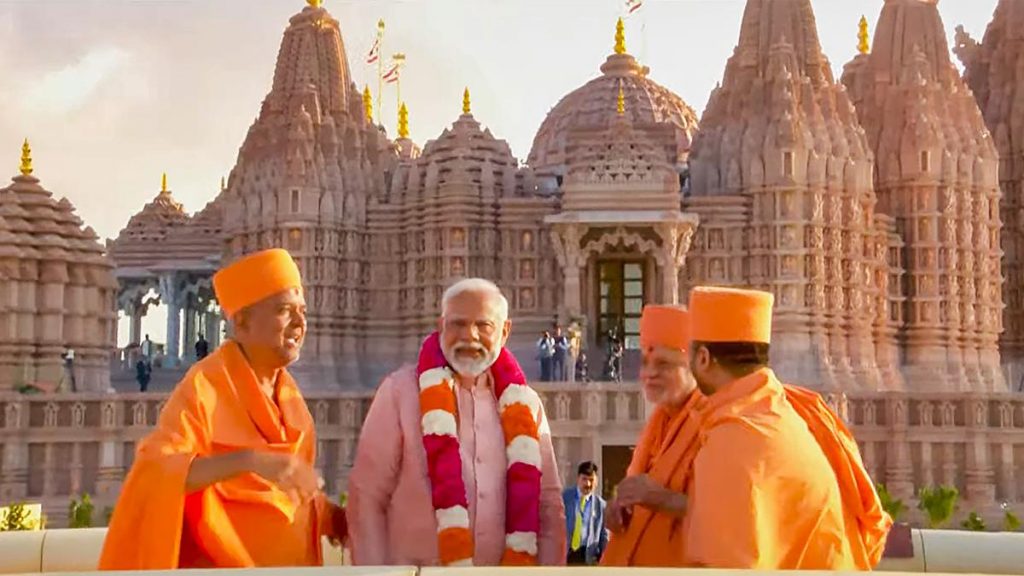Abu Dhabi: Prime Minister Narendra Modi Wednesday inaugurated Abu Dhabi’s first Hindu stone temple, describing it as a symbol of the shared heritage of humanity and thanking the UAE for scripting a new golden chapter of human history.
Speaking at the inauguration of the temple built by the Bochasanwasi Shri Akshar Purushottam Swaminarayan Sanstha (BAPS), the Prime Minister profusely thanked the President of UAE Sheikh Mohammad Zayed Al Nahyan for making the grand temple in Abu Dhabi a reality and said he has not only won the hearts of Indians living in the Gulf nation but also of 140 crore Indians.
“I hope that the BAPS Mandir will become a symbol of communal harmony and global unity for the whole world,” Modi said, addressing a gathering that included UAE Tolerance Minister Sheikh Nahyan bin Mubarak Al Nahyan and spiritual leaders from all faiths.
“We do not see hatred in diversity, we consider diversity as our speciality! In this temple, we will see a glimpse of diverse faiths at each and every step,” Modi said.
He said the UAE, which till now was known for Burj Khalifa, Future Museum, Sheikh Zayed Mosque and other hi-tech buildings, has now added another cultural chapter to its identity.
“I am confident that a large number of devotees will come here in the times to come. This will also increase the number of people coming to the UAE and increase the people-to-people connect between the two countries,” Modi said.
Lauding the contribution of the UAE president in making the grand temple a reality, he said, “If there is anyone who has the biggest and the most significant role in making this grand temple a reality, then it is none other than my brother His Highness Sheikh Mohammed bin Zayed.”
“The Government of UAE has wholeheartedly worked to fulfil the aspirations of crores of Indians. The Government of UAE has not only won the hearts of Indians living in the UAE but also of all 140 crore Indians,” he said.
The prime minister also recalled the consecration ceremony of the newly constructed Ram temple in Ayodhya last month.
“Our immense pleasure in Ayodhya has been further enhanced by the wave of happiness received in Abu Dhabi today. It is my good fortune that I have been a witness to the grand Shri Ram temple first in Ayodhya, and then to this temple in Abu Dhabi,” he said.
“Just last month, the age-old dream of a grand Ram temple in Ayodhya was fulfilled. Ram Lalla is seated in his Bhavan! The whole of India and every Indian is still immersed in that feeling of love,” Modi said.
The prime minister noted that this is not only the time of India’s ‘Amrit Kaal’, this is also the time of ‘Amrit Kaal’ of our faith and culture.
Earlier, Prime Minister Modi, dressed in a light pink silk dhoti and kurta paired with a sleeveless jacket and stole, participated in rituals of a ceremony to dedicate the temple to the people.
Modi met people from different faiths who contributed to the construction of the first Hindu stone temple here.
The prime minister also offered water in the virtual Ganga and Yamuna rivers at the temple before proceeding to inaugurate the temple built on a 27-acre site in Abu Mreikhah, near Al Rahba off the Dubai-Abu Dhabi Sheikh Zayed Highway, at a cost of around Rs 700 crore.
He also inscribed “Vasudhaiv Kutumbakam” on stone using hammer and chisel at the temple.
According to the temple authorities, the grand temple has been built as per an ancient style of construction and creation mentioned in the Shilpa and Sthapathya Shastras, Hindu scriptures which describe the art for mandir design and construction.
“The architectural methods have been clubbed with scientific techniques here. Over 300 high-tech sensors have been installed at every level of the temple to measure temperature, pressure and movement (seismic activity). The sensors will provide live data for research. If there is any earthquake in the region, the temple will detect it, and we will be able to study,” Swami Brahmaviharidas, head of international relations for BAPS, told PTI.
No metal has been used in the construction of the temple and fly ash has been used to fill up the foundation, replacing 55 per cent of cement in the concrete mix, reducing the carbon footprint of the temple.
Madhusudan Patel, the temple’s construction manager, told PTI, “We have used heat-resistant nano tiles and heavy glass panels, merging both traditional aesthetic stone structures with modern-day functionality.
Considering the extreme temperatures in the UAE, the tiles will be comfortable for visitors to walk even in hot weather. Non-ferrous material has also been used in the temple.”
Constructed with 18 lakh bricks, seven lakh man hours and 1.8 lakh cubic metres of sandstone sourced directly from Rajasthan — Abu Dhabi’s first Hindu temple has been made in the Nagara style of architecture, just like the recently inaugurated Ram Temple in Ayodhya.
According to Umesh Raja, a volunteer at the temple, 20,000 tonnes of sandstone pieces were carved in Rajasthan and then shipped to Abu Dhabi in 700 containers.
“Not just the stone, many labourers who helped construct the temple over five years belong to Gujarat and Rajasthan. Even the marble mined from Italy was first shipped to India for carving and then back to the UAE to be used in the interiors,” he said.
The work for the structure has been going on since 2019. The land for the temple was donated by the UAE government. The UAE has three other Hindu temples that are located in Dubai. The BAPS temple, spread over a large area with stone architecture, will be the largest of all in the Gulf region.
PTI
